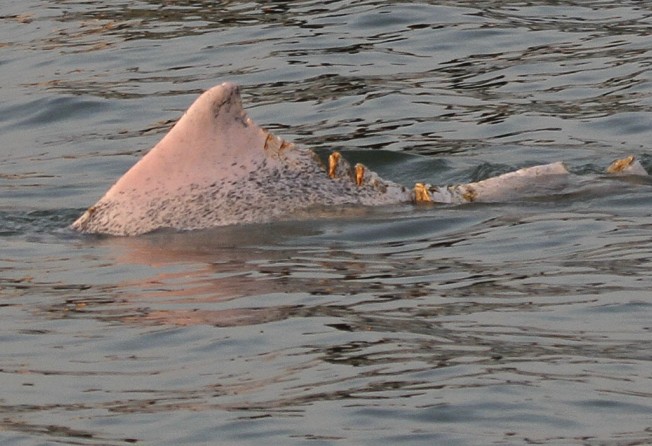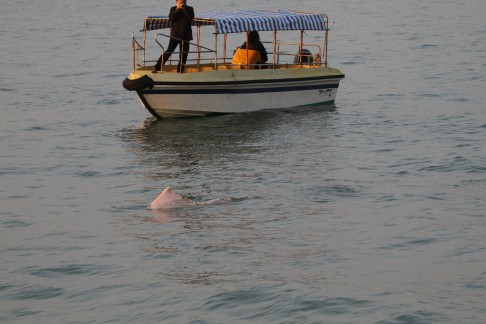Chinese white dolphin receives terrible injuries after 'collision with outboard motor'

A Chinese white dolphin has been spotted off the coast of Tai O sporting horrific slash injuries across its fin and back after what is believed to have been a collision with a tour boat's outboard motor.
Despite its raw-looking injuries, some of which appear to be several inches deep, a marine scientist who observed the dolphin believes it still has a fighting chance, but has urged tour guides operating dolphin-spotting excursions to steer clear of it.
The dolphin was found in waters near the west Lantau Island fishing village at around 4.30pm on Saturday. Video and photos taken by members of the University of Hong Kong Swire Institute of Marine Science, clearly showed the pink-coloured marine mammal swimming along with large gashes on its back and tail.
Dolphin Conservation Society chairman Samuel Hung Ka-yiu, who arrived on scene to assess the animal's injuries, suspected they may have been caused by propeller cuts from the outboard engine of what was most likely a walla-walla - small motorboats often seen in the area for dolphin-spotting tours.
“The injuries are very serious,” said Hung.
Despite the cuts, Hung said the dolphin appeared “surprisingly tough” and was seen swimming, rolling around and even feeding on fish near the water's surface.
He said many more motorised tour boats had arrived at the scene to view the injured dolphin late Saturday afternoon - moves he said could have put the animal at greater risk.
“I urge all these tour boats not to get too close to the dolphin,” Hung said.
Both the Agricultural, Fisheries and Conservation Department (AFCD) and Ocean Park Conservation Foundation received reports about the animal's condition. The latter dispatched its cetacean stranding response team to search the waters of Tung Chung and Tai O, but said it could not find the dolphin.
“As shown in the photos, the dolphin's back and tail were severely injured, possibly caused by vessel collision,” the foundation said. “We will closely monitor the situation. Meanwhile, Ocean Park's vet and Marine Mammal Team will stand-by and assist any further operation.” It urged anyone who sees the dolphin to inform the AFCD.
Hung said that at this point, based on its behaviour, the dolphin would not need any further intervention including any rescue or rehabilitation. “The last thing we want to do is to disturb this animal further,” he said.
The combined estimate of dolphin abundance in west, northwest and northeast Lantau survey areas in 2013 was 62, similar to the 2012 estimate, according to the Agriculture, Fisheries and Conservation Department. Both estimates were the lowest of the past decade.
